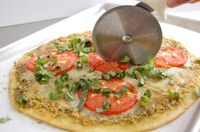Prairie Fare: Enjoy an Autumn Feast for Your Eyes
(Click an image below to view a high-resolution image that can be downloaded)
By Julie Garden-Robinson, Food and Nutrition Specialist
NDSU Extension
As I drove on a highway in northwestern North Dakota, I enjoyed a feast for my eyes.
I was en route to a late-September workshop to talk about preserving summer’s colorful bounty.
In wooded areas, the leaves were turning brilliant shades of yellow, gold and orange, occasionally punctuated by bright red foliage.
I tried not to get distracted by the beautiful scenery.
As autumn progresses and the temperature decreases, the chlorophyll pigment in green leaves breaks down to reveal the yellow and orange carotenoid pigments and/or the red anthocyanin pigments.
The pigments were there all along; they just are covered by the green pigments.
Of course, eating colorful leaves from trees is not a recommendation, but eating colorful fruits and vegetables is. Most of us shortchange ourselves on the 4 1/2- to 5-cup daily recommendation for total fruits and vegetables of all colors.
I have been reading some historical nutrition documents lately. The recommendation to eat a colorful diet goes back many decades. As I recently paged through a vintage nutrition guide written during World War II, I came upon a quiz about nutrition.
I needed a score of 60% to pass, according to the author. I was a little nervous as I took the nearly 80-year-old nutrition test. Nutrition recommendations have changed quite a bit.
The good news: I answered the questions correctly. However, I needed to ponder what might have been known at the time of World War II.
If I had failed, I think I would have tried the test again the next day after recovering my confidence.
Many of my readers might remember learning about the Basic 4, the Food Guide Pyramid and/or MyPyramid. Nutrition guides date back to the “Principles of Nutrition and Nutritive Value of Food” published in a farmers’ bulletin in 1904.
Our modern-day guide, “MyPlate,” includes five food groups. We are advised to fill half of our plates with fruits and vegetables.
The U.S. government introduced the “Basic 7 Food Chart” in 1943, and some of the nutrition information about fruits and vegetables was based on color.
I have a quiz for you. Can you name the Basic 7 Food Groups?
Pause a minute and think what might have been the advice for you, your parents or grandparents, depending on your age.
Group 1 of the Basic 7 consisted of green and yellow vegetables, including leafy greens, peas, snap beans, carrots, tomatoes, pumpkins, yellow squash and any other green or yellow vegetables. Most of these foods were a good source of vitamin A, which helps maintain the health of our eyes and skin.
Group 2 consisted of oranges, tomatoes and grapefruit. Raw cabbage, peppers, turnips and berries also made the list. This group was an excellent source of vitamin C to keep our immune systems strong.
The Basic 7’s Group 3 included potatoes and other vegetables and fruits not included in the previous groups, including beets, celery, corn, cucumbers, onions, apples, grapes and bananas.
Group 4 included milk products, and Group 5 included meat, poultry, fish and eggs. Group 6 was the bread and grains group.
Group 7 was quite interesting to me. Butter and fortified margarine used to be a “food group.” However, the Basic 7 Food Guide reminded people to “use in moderation.” Some advice doesn’t change.
See https://tinyurl.com/NDSUExtensionWhatColor to view a publication about the value of colorful food and the current recommendations, including food safety guidelines. In the spirit of autumn, here is a modern-day recipe with some colorful vegetables.
Margherita Pizza
1 pizza dough
5 Tbsp. basil pesto
1 c. shredded mozzarella
2 to 3 tomatoes, thinly sliced
1 Tbsp. olive oil
1/8 tsp. salt
2 Tbsp. fresh basil, shredded or finely chopped
Optional toppings: chopped red, yellow or green peppers
Prepare homemade or store-bought pizza dough per instructions. Preheat oven to 425 F. Shape the dough onto a lightly greased pizza or sheet pan, spread the pesto on the dough, then top with shredded mozzarella and sliced tomatoes. Drizzle with a tablespoon of olive oil and salt. Bake for approximately 10 to 12 minutes or until crust is baked and cheese is melted. Top with basil just before serving.
Makes eight servings. Each serving has 250 calories, 13 grams (g) fat, 9 g protein, 25 g carbohydrate, 1 g fiber and 540 milligrams sodium.
(Julie Garden-Robinson, Ph.D., R.D., L.R.D., is a North Dakota State University Extension food and nutrition specialist and professor in the Department of Health, Nutrition and Exercise Sciences. Follow her on Twitter @jgardenrobinson)
NDSU Agriculture Communication - Oct. 3, 2019
| Source: | Julie Garden-Robinson, 701-231-7187, julie.garden-robinson@ndsu.edu |
|---|---|
| Editor: | Ellen Crawford, 701-231-5391, ellen.crawford@ndsu.edu |



